History
Chicago North Shore & Milwaukee Railroad
The Chicago North Shore & Milwaukee Railroad will probably be remembered as one of the greatest of all electric interurbans for its high speed, high capacity and magnificent roadbeds. It was a pioneer in radio-equipped parlor-lounge cars, had one of the first mechanical refrigerator cars, and in 1926 pioneered the piggyback movement of truck trailers on flat cars. Also, in 1941 it introduced the first air-conditioned streamliners on any interurban.
The earliest North Shore precursor was organized by local businessmen at Waukegan, Illinois, in October, 1891, as the Waukegan & North Shore Rapid Transit Company with a seven mile system in Waukegan. By 1894, the Bluff City Electric Street Railway Company succeeded and ran trackage between Waukegan and North Chicago. Financial difficulties developed, and the line was sold to A. Frost and George A. Ball and reorganized as the Chicago & Milwaukee Electric Railway Company. By 1898 the line extended thru the lake shore communities from Lake Bluff to Highland Park.
In 1899 a ten-mile extension was completed to Evanston. Passengers were transferred at Evanston to a Milwaukee Road steam train to complete their ride into downtown Chicago. Several years later a new entry into Chicago was laid out from Evanston using several other trolley line companies for their journey downtown.
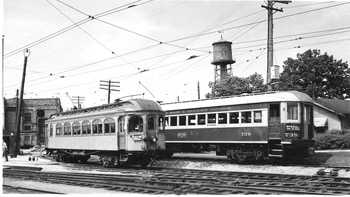
#300 & 736, Highwood Shops, Illinois, July 1, 1939
By 1904 Wisconsin’s division extended from Lake Bluff to the Wisconsin State Line and Milwaukee. Double track was laid with 80 pound rail on white oak ties, and gravel or crushed stone was used for ballast. The right-of-way being 100 feet wide insured the quality of high speed railroading. Between Lake Bluff and Kenosha, a distance of 20 miles there were only two curves. To maintain the high standard the cuts into Milwaukee were deep with some embankments as high as 75 feet. By December 2, 1905, the new line was extended into Kenosha, and with this connection, it was able to connect with the TMER&L Co. for interurban and Kenosha Electric for local street car service. Running time between was about five-hours, some three hours greater than the steam railroad, but the $1.25 cost for a one-way trip was less than half the steam line fare.
By September of 1906, ten more miles was gained into Racine with increasing earnings for the Company. But a year later, the company was in financial problems again with track laid within eight miles of Milwaukee. The 1907 financial collapse of the country brought a halt to the construction and, by 1908, forced the company in bankruptcy.
Receivers of the bankrupt line completed the construction into Milwaukee and service began on October 31, 1908. Initial service over the 73 mile route between Evanston and Milwaukee was provided by hourly local trains operating on 2 hour 45 minute schedules.
Nine interurban cars designed expressly for the limited train service were delivered by the Jewett Car Company early in 1909. Construction of wood and steel center sills, the cars was 52 feet 6 inches in length and weighed 76,000 pounds. Combination cars were divided into baggage, smoking, and passenger compartments, seating a total of 42 passengers, with wooden drop seats provided in the baggage compartment for additional seating when needed. Interiors of these cars were finished in mahogany, and seats were upholstered in green finished plush, with the exception of those in the smoking compartment, which
were covered in green leather.
Appointments in parlor-buffet cars were considerably plusher. With the exception of the richly finished mahogany woodwork, interiors were finished in a green décor, and the floors were covered with thick green carpeting. Portable wicker armchairs, with green leather cushions and trim, provided accommodation for a total of 27 passengers. Portable tables were available for buffet service which was provided from a fully equipped kitchen and pantry.
Despite the extended bankruptcy that began in 1908, the Chicago & Milwaukee made modest gains in traffic following the completion of the route of Milwaukee. The sixteen new interurbans were delivered in 1910, and the company had a net income of almost a quarter of million dollars. A lack of a direct entrance to the Chicago Loop and changing trains to steam made it a handicap. However it became evident that some negotiation of a suitable agreement between Northwestern Elevated Railroad and Chicago & Milwaukee was needed to gain access to the downtown area of Chicago.
Samuel Insull was a utilities tycoon who became interested in the Chicago & Milwaukee Railroad and in 1912 tried to acquire the railroad but failed, when the courts nullified the sale because the price was too low. Later an agreement was reached on the reorganization plan, and on May 1, 1916, the Chicago & Milwaukee was sold to an Insull-backed organization for $4,550,000 and renamed the Chicago North Shore & Milwaukee Railroad. The stage was set for reconstruction and expansion of the system. Samuel Insull himself became chairman of the board of the new Chicago North Shore & Milwaukee Railroad. Britton I. Budd was elected president of the company and actually directed the Insull rebuilding program. In 1914, Britton Budd became president of the Metropolitan Elevated Railway Company, and Insull picked him to head the new consolidated elevated system.
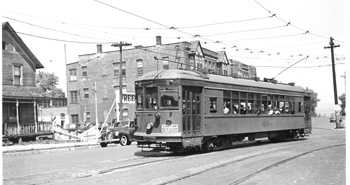
#356, Waukegan, Illinois, Merchants Curve
By the end of 1917 the Insull management had spent over a million dollars for improvements to the Chicago North Shore & Milwaukee line. Many bridges were upgraded from wood to concrete, 65,000 ties were replaced, new automatic substations were installed and a number of new stations were built and remodeled. Passenger service was improved and 15 steel passenger cars were purchased; by the end of 1917 the North Shore had 30 high speed limited trains between Evanston and Milwaukee. By the end of Insull’s first year, ridership increased from seven million passengers to ten million; by 1918 passenger service had reached twelve million. Great Lake’s naval base had as many as 40,000 men at times, and such occasions required additional cars to handle the passenger traffic.
On August 6, 1919, the North Shore had true service between Chicago and Milwaukee operating directly over the Elevated with a main station at Adams Street and Wabash Avenue in the downtown Loop. On September 15, 1920, the company opened a new terminal in Milwaukee at Sixth and Michigan streets. Built at a cost of $600,000, the new structure was said to be, with considerable exaggeration, the largest electric railway terminal in the United States.
Early in the 1920’s, 30 new interurban cars came from Cincinnati Car Company, fifteen of them trailers while 15 were motorized. These cars had the speed capability of 80 m.p.h. In the mid twenty’s the railroad was operating a total of 160 daily trains which included 44 daily limited trains between Chicago and Milwaukee. On February 15, 1922 the Milwaukee Limited train was extended over the elevated system to a terminal at 63rd and Dorchester on Chicago’s South Side. Another order of 40 cars was made in 1922; unusual features of these cars were dual electric and coal fired hot water heating systems. This order included a dining car and two parlor-observation cars. By 1925 the North Shore dining cars were serving some 75,000 meals a year, and its parlor cars were transporting 39,000 extra fare passengers annually.
The many achievements of the North Shore Line were recognized in 1923 by the first Charles A. Coffin gold metal “for distinguished contribution to the development of electric transportation for the convenience of the public and the benefit of the industry”. This award was established by the General Electric Company in honor of the retirement of Charles A. Coffin, one of its founders and a former president of the company.
One of the most successful advertising schemes of the North Shore was its artistic billboards and lithographed posters. The masterpieces of display advertising art were widely used by the North Shore Line advertising the speed of the line between Milwaukee and Chicago. Another feature was that the parlor cars were equipped with radio equipment, which proved music in the cars and of transmitting by radio-telephone to points as far as 15 miles away. Still another feature was that phonographs were installed, and passengers were able to choose musical selections ranging from classical works to jazz.
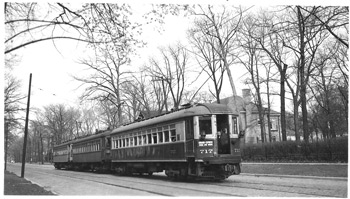
#717, Wilmette, Illinois, December 4, 1949
With the many improvements that were made on the North Shore, the older “shore line” route still involved extended operations through city streets. Many of the local communities had speed and carload freight restrictions which made slow moving. To solve this problem, the company decided to reconstruct the shore line and provide a new high speed cut-off through the Skokie Valley several miles to the west of the original route. Construction of this route would provide several benefits make into; since the Valley was mostly undeveloped, and the growth of the Chicago area would encourage rapid development with fast transportation services. Construction of a five-mile section of double track cut-off, extending to Niles Center from a junction with the old route at the Howard Street elevated station, was started on April 4, 1924, and was completed in less than ten months. A new 2,000-KW automatic substation was constructed to supply power to the new line, and a third rail power distribution system was installed on most of the route. Eight ornate finished stations provided with high level platforms and canopies were constructed on this line. Passenger service between Howard Street and Niles Center was opened on February 1, 1925. Construction of the remaining 18-mile section between Niles Center and a junction with the Libertyville branch was begun in June of 1925 and was rushed for completion within one year.
Power was supplied to the final section of the cut-off by five new substations. Three interlocking plants were also required. Anticipating a greatly increased traffic over the Libertyville branch, a new Mundelein terminal was constructed The opening of service over the new line on June 5, 1926, was celebrated amid great fanfare and expressions of confidence in a golden future. Also in that same year, the Cincinnati Car Company delivered 20 more interurban cars and three dining cars. With the inauguration of the new line, running times for the Chicago-Milwaukee trains were reduced by as much as 25 minutes, and a new hourly service was installed on the branch to Libertyville and Mundelein.
In 1927 there were signs of trouble in the North Shore balance sheets. For the first time there was a decline of passenger traffic, and income dropped below a half million dollars for the first time in six years. The company said it was only a minor problem but could see a bright future. In 1927 more new equipment was ordered which included two freight locomotives, ten plush upholstered lightweight city cars for Waukegan and Milwaukee service, and 18 steel interurban cars from the Pullman Car & Manufacturing Company. Only two years later, another 25 interurban coaches were ordered from Standard Car Company for delivery in 1930.
Both 1928 and 1929 were very good years for the North Shore. Gross revenues continued to increase, and net income climbed back up to around three quarters of a million annually despite the widening depression that followed the November, 1929, stock market crash.
Then, in 1931, the bottom fell out. Operating revenues were down almost three million in only two years; salary cuts were ordered, dividends were suspended, and the North Shore ended the year with a net loss of almost $750,000. The next year it was even worse, and by the end of September, 1932, the North Shore was unable to pay its bills, following much of the Insull’s empire which fell into bankruptcy. Insull was forced to resign from the board, and the North Shore would never be the same again.
By 1932 the North Shore was making a painful recovery with lesser losses. It continued to display a high level of performance throughout the depression years. A WPA project in the late 1930’s, together with the North Shore and CNW, carried out an extensive grade separation project at Glencoe, Winnetka and Kenilworth on its Shore Line Route. It was nearly four-miles long, and eliminated over a dozen grade crossings as well as two stretches of operation through city streets.
In 1938 a labor strike paralyzed the company for 51 days, and serious consideration was given to abandoning the entire system. Highlighting a dramatic recovery of passenger traffic, two new streamlined (#801-802) and (#803-804) “Electroliner” train were ordered from the St. Louis Car Company in 1939 to be placed in service in 1941.
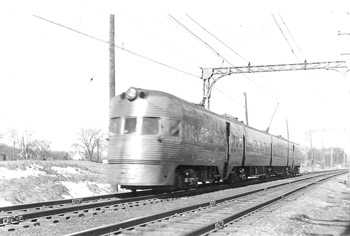
#801-802, North Chicago, Illinois, February 17, 1946
The Electroliners were built by the St. Louis Car Company and faced an almost impossible set of specifications set by the North Shore. The North Shore wanted a high speed luxury streamliner that could hold its own against the “Hiawatha” and “400” competition of its steam road rivals. Yet the trains had to trundle, trolley car fashion, through Milwaukee streets, and had to contend with severe restrictions of the Chicago elevated system. St. Louis Car Company produced an ingenious solution to the design problem. The curvature restrictions were solved by designing a four section articulated train 155 feet 4 inches in length, and the width limitations were overcome by the adoption of a “fish belly” cross section which bulged out above the platform level to a maximum width of 9 feet 2 inches. The coaches could accommodate seating for 120 passengers. Each car employed eight motors which gave it 1,000 horsepower providing power for speeds of 85 m.p.h. With the use of field shunting, the trains were capable of speeds in excess of 100 m.p.h. The cars had all the modern conveniences of the steam railroads and were officially dedicated on February 6, 1941.
When the North Shore line was abandoned in 1963 the two sets of Electroliners were ready for the cutting torch. But the Philadelphia Suburban Transportation Company purchased the trains for operation over its “Red Arrow Lines”. The Red Arrow refurbished the cars and gave them new names “Valley Forge” and “Independence Hall”. The two sets were in operation until 1979 when they were retired. Cars #801-802 (Valley Forge) went to Illinois Railroad Museum for restoration and cars #803-804 (Independence Hall) are at Rockhill Trolley Museum in storage.
In 1940, some 42 steel coaches and dining cars were extensively improved and refurbished for operation on both Chicago-Milwaukee Limited trains and Shore Line Route suburban services. New seating and lighting were provided, heating and ventilating systems improved, and sound-reducing ceilings and rubber tiled floors installed. The War brought back, for a few brief years, a traffic level comparable to that of the great years of the 1920’s. Total passenger traffic climbed from barely ten million revenue passengers in 1940 to almost twenty eight million by 1945. By November of 1946 after nearly fourteen years of bankruptcy, the North Shore came back. But, trouble and crisis returned swiftly at the War’s end. Passenger traffic dropped and kept on declining. Local street car services in Waukegan and North Chicago were converted to bus operations in 1947.
In 1948 another prolonged strike, this one lasting more than three months, shut down the system; only a better than 40 percent commuter fare increase enabled the company to meet the resultant wage increases and resume operations. Dining car service, except tavern-lounge service on the Electroliner trains, was discontinued in 1949 and local streetcar service in Milwaukee was abandoned in 1951.
Late in 1948 the company began an effort to abandon the commuter service on the 37 mile Shore Line route. It was turned down by the Illinois Commerce Commission in 1951, but a renewed Shore Line abandonment effort was finally successful in 1955. In June, 1958, the North Shore was back again and asking for permission to abandon all operations.
Clouding the issues as the North Shore fought for permission to end operations was its relationship to Susquehanna Corporation, the Delaware holding company which owned the railroad. Founded in the illogic of US tax Laws, Susquehanna originated with a voluntary North Shore reorganization in 1953, under which some five million dollars of North Shore assets were used to create the holding company. Assuming ownership of the North Shore and its several subsidiary bus operations along with diversification into other businesses, Susquehanna had made a good thing out of writing off the North Shore’s operating losses against its profit in other activities and stood to profit even more in the form of tax credits from the abandonment of the North Shore. Opponents to the abandonment charged, with understandable suspicion, that Susquehanna had no interest in keeping the North Shore continuing.
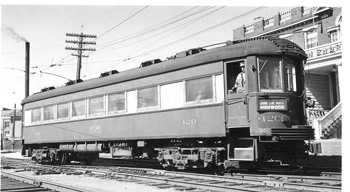
#420; Highwood Shops, Illinois, April 8, 1949
After all that was said about the various claims about Susquehanna Corporation, the facts remained that, with the economic conditions prevailing in the 1960’s, the viable private enterprise was a virtual impossibility. The impact of the private automobile on the North Shore Line also showed that with a decline from over sixteen million passengers in 1923 to barely four million in the mid 1960’s.
After nearly a year of hearings, the Interstate Commerce Commission recommended approval of the abandonment. Protests from the Illinois Commerce Commission and commuters brought more hearings, and the ICC reversed its examiner, ordering the North Shore to keep going another year and to attempt to improve its financial condition. Increased revenues from a 23 percent fare increase were offset twice over by a simultaneous wage increase; and, to matters worse, the opening of a new expressway into the Chicago Loop late in 1960 cost the North Shore more that 40,000 passengers a month.
Early in 1961 the North Shore was losing more money and renewed its abandonment plea. More protests and more hearings were held. The matter went to Federal Court in 1962, and the court stated that the ICC did indeed have the authority to permit the abandonment, and the company set January 21, 1963, the date to end all operations. A last ditch effort by the North Shore Commuters’ Association to raise the funds needed to purchase and operate the railroad themselves failed.
Finally then, during the early morning hours of January 21, 1963, the interurban cars sped through the snow-clad Illinois and Wisconsin countryside for the last time as the midnight trains from Chicago and Milwaukee made their final runs. At 2:50 a.m. the last southbound train stopped at Chicago’s Roosevelt Road station, and five minutes later the last North Shore train rolled into the Milwaukee terminal. The trolley poles were pulled down and hooked, and the lights in the terminal were turned off ending an American interurban era.
